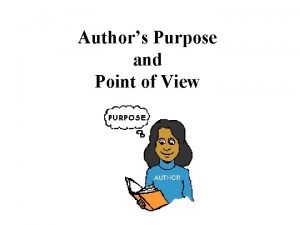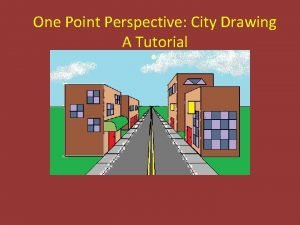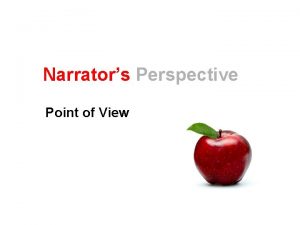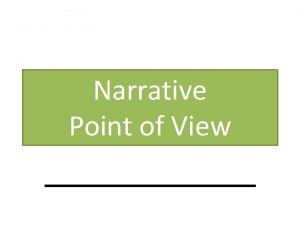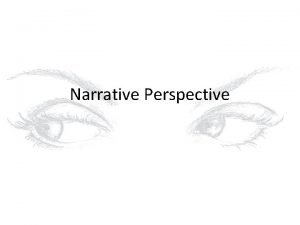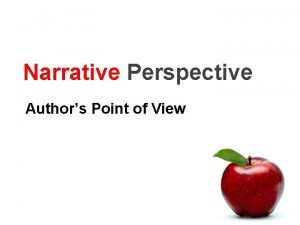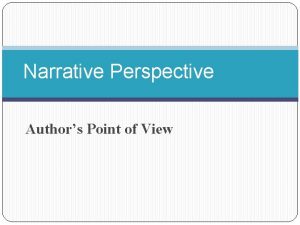Narrative Perspective Authors Point of View Dialogue and















- Slides: 15

Narrative Perspective Author’s Point of View

Dialogue and Narration • Dialogue = when characters speak. • Narration = when the narrator speaks. • “Quotation marks” separate narration from dialogue. Example “Help” my cousin Jack said. 1 2

Pronoun Case We are trying to figure out the narrator's view point on the story. Perspectives and Signal Words First-Person I, me, my, mine, we, us, ours, Second-Person you, your Third-Person he, she, her, they, them (also character's names)

Secret “I am in the room” I = 1 st Person “You come in the room. ” You = 2 nd Person “Then he or she came in the room. ” He or She = 3 rd Person

3 rd Person • OMNISCENT – Narrator tells thoughts/feeling of more than 1 character. • LIMITED – Narrator tells thought/feelings of one (1) character. • OBJECTIVE – Character dialogue and actions narrated.

First-Person Narration The Story Characters I or We the Narrator The narrator is involved in the story.

First-Person tells “me” or “my” story. Example I went to the store with my friend. The clerk said, “Hi. ” We bought candy and left. Who is telling the story? In First-Person the narrator is “I” or “we. ”

Second-Person Narration The Story Characters (if any) You the Reader The reader’s actions are narrated.

Second-Person tells “your” story. Example You stayed up late last night and now you’re tired, but you need to pass this class. From whose perspective is the story told? In Second-Person the perspective of “you” is narrated. It is mainly used for instruction or directions.

Third-Person Narration The Story Narrator Characters “He” “She” “They” The narrator is outside of the story.

Third-Person tells “his” or “her” story. Also will refer to characters by name Example Chris loved basketball. Everyday he played after school. When it got dark, he watched it on TV. From whose perspective is the story told? In Third-Person the perspective of “he” or “she” is narrated.

Third-Person Omniscient Narrator is all knowing. Narrator tells thoughts and feelings of more than one character. Omni = All Scient = Knowing Example Tim was mad at Shay. He blamed her. Shay knew Tim would be mad, but she wanted to live her life.

Third-Person Limited Narrator is limited to one character. Tells thoughts & feelings of one character Example Tim was mad at Shay. He blamed her. Shay just left without saying anything. She left a note and then left him.

Third-Person Objective Narrator does not reveal any character’s thoughts or feelings. Only character’s dialogue and actions are narrated. Example Tim slammed the door. He walked upstairs & read a note from Shay. He kicked her trash can & started crying.

Practice 1. Read the following passages. 2. Determine the narrator’s perspective. 3. Write down your answer.
 1 point vs 2 point perspective
1 point vs 2 point perspective Authors point of view
Authors point of view Authors point of view
Authors point of view Vanishing point
Vanishing point 1 point perspective street view
1 point perspective street view The sociological perspective is a point of view that
The sociological perspective is a point of view that Narrator's perspective
Narrator's perspective Congratulating and responding
Congratulating and responding Identifying narrative perspective
Identifying narrative perspective Third person limited
Third person limited Author perspective
Author perspective What is authors perspective
What is authors perspective Silo perspective vs business process perspective
Silo perspective vs business process perspective What is perspective in a story
What is perspective in a story Identifying narrative perspective
Identifying narrative perspective One point perspective from plan and elevation
One point perspective from plan and elevation

